As an Amazon Associate I earn from qualifying purchases.
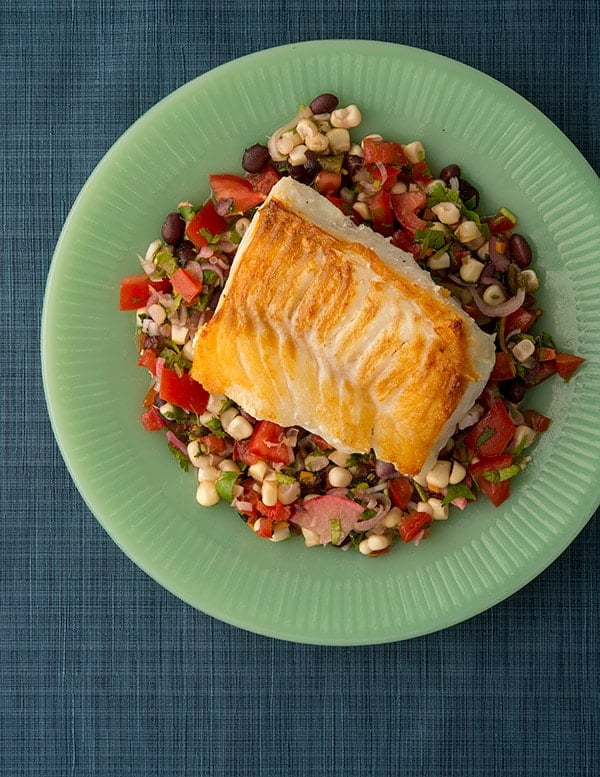
Pan-seared cod is one of my favorite ways to eat this fish. It’s a classic restaurant technique you can easily do at home.
Let me walk you through it. First, you need a substantial piece of fish, not a skinny fillet. Second, you need the fish to be dry. Third, you need the right pan and oil, and finally you need patience.
I know it sounds obvious, but your goal is pan-seared cod, not pan-fried cod. So no flour or batter for this one. The goal is to sear, to caramelize, one side of the fish while not overcooking the rest.
To really do this, you need a piece of fish, cod or otherwise, at least as thick as your thumb, about a half-inch or thicker. And an inch is better. Why? Thin fillets will overcook before you get that nice sear. Also, they tend to be fragile. Pan searing is a fierce method of cooking.
I’ll say it again: Any thick piece of fish can be pan seared, not just codfish.
Also, the fish can be skinless or have its skin, obviously scaled — unless it’s salmon or mackerel, which I never scale. If you are using a skin-on fish, you sear the skin side. If you are searing a skinless fish, sear the side that used to have the skin. Why? Because it is flatter. Incidentally, pan-seared cod is best skinless, at least in my opinion.
I pre-salt my fish an hour or so beforehand, to season it and bring some moisture to the surface. You then dry the fish thoroughly with paper towels before searing.
Now, the pan. Yes, you can sear fish in a non-stick pan, but it’s not ideal because the teflon doesn’t like the intense heat you need for a good sear. But, if you are dealing with a very thick piece of fish, like a block of Pacific halibut or king salmon, you will want to use medium-high heat instead of high, so you can use a teflon pan.
I prefer a stainless steel pan with slanted sides, but a properly seasoned cast-iron pan will work well, too. The ideal, what we used in the restaurant years ago, is a black steel pan with slanted sides. All are non-stick to some extent and hold heat well.
The general idea is this: get the pan hot, put a little oil in it, let that get almost to the smoking point, then place the fish down. Let this cook until you get the sear, drop the heat, add butter and baste the other side of the fish until it’s done.
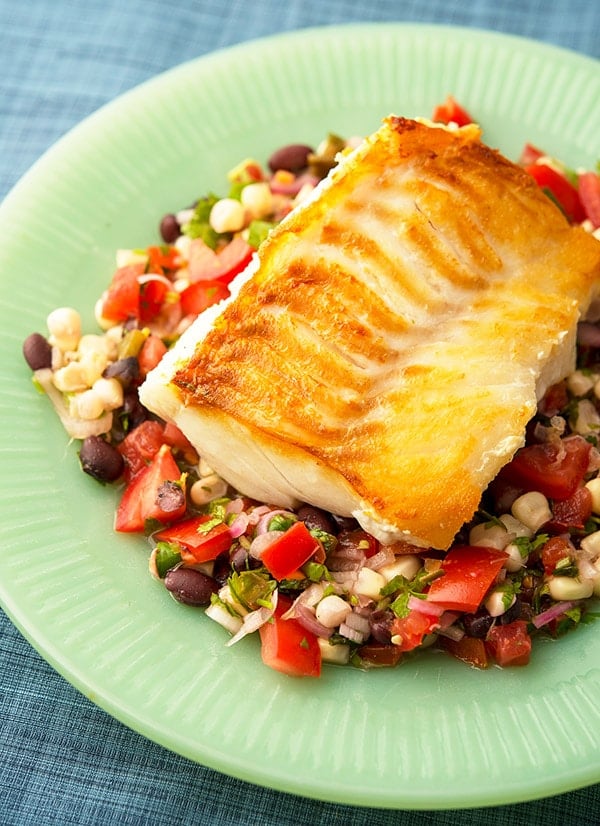
Your oil needs to be sturdy, with a high smoke point. In order of preference, I use avocado oil, rice bran oil, grapeseed oil, canola oil, safflower oil. All are very high smoke point oils that can stand the heat.
Note that pan-seared cod, or any other fish, isn’t flipped. You sear the one side crispy, drop or even remove the pan from the heat, add butter and baste the rest of the fish with the hot butter until it’s cooked through.
Serve your fish with anything you like, really. I typically raid the garden and make a salad. Oh, and if you want a sauce, it goes under the fish — you want the crispy side to stay crispy, no?
Pan-Seared Cod
Ingredients
- 1 to 1 1/2 pounds cod
- Salt
- 1 tablespoon avocado, grapeseed or canola oil
- 4 tablespoons unsalted butter
Instructions
- Salt the blocks of fish well and set in the refrigerator for one hour.
- Get your pan hot over a high heat burner, about 2 minutes. While this is happening, pat the fish dry with paper towels. Make sure it's dry. Add the tablespoon of oil and swirl it around. It will heat up very fast.
- As soon as you see a wisp of smoke coming from the oil, lay the fish pieces down in the pan, well spaced, skin side down (or the side where the skin used to be). Turn the heat down to medium-high and let them cook, undisturbed, for 5 minutes, or until you see the bottom starting to caramelize. Using a thin metal spatula, ideally a fish spatula, carefully try to lift the fish from the pan. It should come up easily, or stick in only one or two spots. If not, keep cooking it -- the fish will release when it's ready.
- When that happens, add the butter, and once it melts, drop the heat all the way to low. Use a spoon to baste the butter over the pieces of fish until they turn opaque. You will need to tilt the pan to do this properly. Serve the fish seared side up.
Video
Nutrition
Nutrition information is automatically calculated, so should only be used as an approximation.
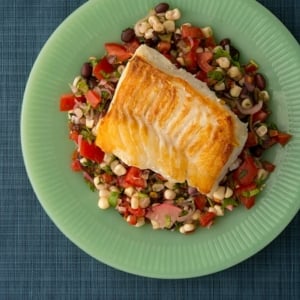

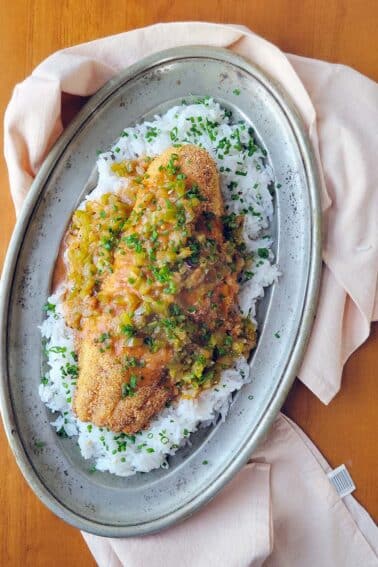
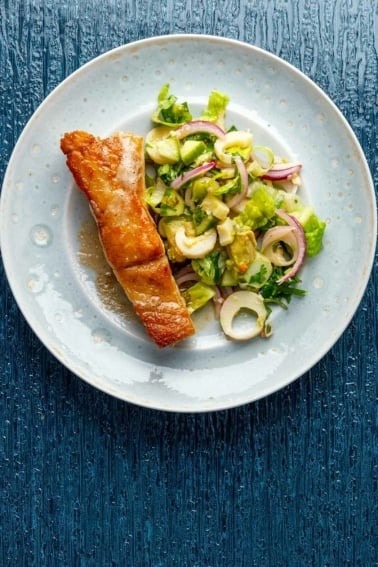
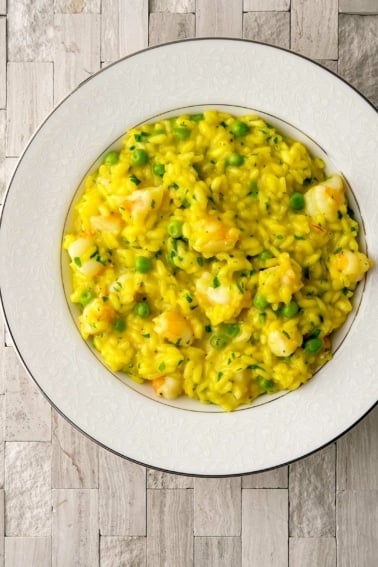
Great Recipe, the success was searing it on one side for 5 minutes until it released from the cast iron. The basting butter from the skillet
was delicious on our rolls.
Delicious!!! Turned out perfect!! I enjoyed the simplicity. Will definitely make again.
Thank you for teaching me how to do this. I made this cod as directed, however, I felt lost at the butter basting part. It was difficult for me to determine when the fish was done; I had to kind of pry into the very thick fillet to check. What would help greatly is if you could make a youtube video for us to watch the process in real-time. Pleeeeeeeeeeeeeeease, and thank you again for this tasty and simple recipe 🙂
Do Androids Dream: I am actually working on one, so stay tuned!
Any recommendations on butter substitute here? Can I make this heart-healthy without the butter?
Sherry: If you use ghee it will be much lower in saturated fat. That’s what I use normally. But any oil that you like will do.
I just tried this recipe today and it was AMAZING, thank you so much! I cook with frozen fish a lot and it came out beautifully flavorful and moist. I’ll be making this a lot going forward.
Served this tonight with saffron risotto (from a bag) and steamed broccoli and a chunk of lemon — incredible! This will now be my go to recipe for cod, and I’m looking forward to trying it with other fish. The straightforward technique makes for a very satisfying recipe. Thank you so much!
Delicious, simple, and easy! I served mine with olive tapenade and lemon, and yellow rice. Beautiful too!
Tried this recipe tonight for dinner! It was delicious!! Thanks for the recipe and the helpful ‘cooking fish’ tips!
This was absolutely delicious! Best method I have found to cook cod. I will definitely be trying this method on sea bass as well.
I love the prep description. My only worry is no seasoning on fish (only salt), or that my picky eaters would think it bland. Yes, I could serve it with a zesty sauce or side, but dumb question: it’s flavorful enough with just salt? Presume any other seasoning on fish besides salt would burn/smoke with this method. Thanks
KMoore: Yep you are correct, they will burn. If you want other seasonings, sprinkle them on when the fish comes off the stove.
I’ve sprinkled freshly ground black pepper on both sides. It turned out very good. Also, while adding the butter for the second cooking stage, I’ve also added three diced tomatoes around the fish. That turned out to be a nice “sauce” to add on top of the fish before serving.
Thanks for the technique! Would you recommend this for walleye? Or any other freshwater fish (Bass or Pike)?
Brett: Any fish at least 1/4 inch thick will work with this method. Thinner fillets can be too delicate for it.
While sitting at the chef’s counter at Hot & Hot Fish Club, I’ve noticed that they will often sear fish like this in two stages. They will do a very hot and short sear, remove the fish from the pan and let it rest on a paper towel for a while. Then re-sear and/or finish it in the same pan. Result is super-crispy on the seared side. Any insight on this version of the technique?
Marcus: It’s just for pick-up. You do that initial sear and then when a diner orders that fish, they can finish it very quickly.
Since seeing this technique in a previous post,this is now my go to way to cook just about any fish! But I’ve started using walnut oil, I like the taste it adds!!
Did you add any vinegarette or something to the veggie mixture on the bottom. I see corn, beans, red onion, green pepper, tomatoes and some fresh spices. Looks fantastic. This mixture underneath takes it to the next level.
Greg: Probably. I can’t remember I usually add citrus or vinegar, plus an appropriate oil, like olive or somesuch.
Thanks, tried cooking fish many times wanting that nice crispy golden surface but it has never worked until I follow your steps today. Thanks a lot for sharing the tips.
Could you talk about fresh cod vs bacalhau for searing? In Portugal bacalhau is still usually served when they now have perfectly good fresh cod available–even for pan searing. I can understand using it for bacalhau à brás or fritters…
Sounds great! Love this method. You mention that you never scale your salmon; does this include the larger ones? If you’re pan searing salmon with skin on, do you eat the scales too? I’ve always scaled the salmon I get from the store because the scales seem to large to eat. Thanks again!
What is this glorious concoction you have under the cod?
Jared: Stuff from the garden, tossed together.
Thanks Hank! Can’t wait to practice this method. Going to start shopping for a carbon steel pan too.
Great recipe Hank!
Thanks
This looks great! One problem I have with cooking fish on the stove is that it makes my house smell to high heaven like its a regular long John silvers and it doesn’t go away. Any tips to keep this from happening. Thanks
Tom: The easy answer is to cook fresher fish. Fresh fish won’t smell like that. Also, use your oven fan. Beyond that, one trick is to wash your fish in lemon or lime juice before you cook it, patting it dry before it hits the pan.
I hadn’t heard of the pre-salting then drying, will try that. And I’ll try this with Cabillaud, the most popular white fish I can get here in Bordeaux. I’ll bet you’re familiar with it? Cheers from the other side of the Atlantic!
Lynn:
Interglot says: le cabillaud (m) ? Cod